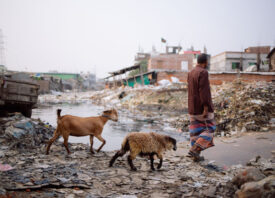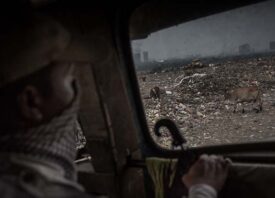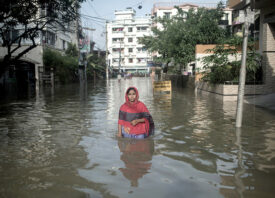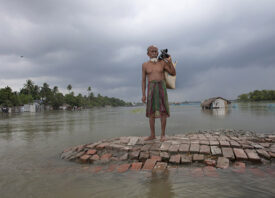Search this site
People in Bangladesh Are Among the Least Responsible for Climate Change. Yet They’re Bearing the Brunt of It.


“These people do not have to bear this situation for one day,” the photojournalist Zabed Hasnain Chowdhury, who has been documenting the lives of those affected by flooding in northern and central Bangladesh, tells me. “They endure it for months.” During that time, the floods might take everything–their homes, their animals, their crops, their food, and even clean drinking water. It happens every year, and it’s getting worse.
Two years ago, he traveled to Bogura, Bangladesh, to tell the stories of individuals and families living amid the floods. That same month, news broke that a quarter of the country had been flooded, with flooding expected to get even more severe around the Brahmaputra River as the climate crisis worsens. The flooding affected the lives of millions of people, with dozens killed. Schools were destroyed, and houses were washed away.
Somini Sengupta and Julfikar Ali Manik, writing at the time for The New York Times, emphasized at the time that the people suffering the most were also among those who bear the least responsibility for climate change, with the average person in Bangladesh responsible for just small a fraction of carbon emissions. Estimates suggest the average Bangladeshi emits 0.56 tons of CO2. The average American, on the other hand, emits 14.24 tons.
Chowdhury believes the people he met agreed to be photographed so that the world could hear their stories. He listened to them recount their experiences, and he promised them the pictures would be published and seen. The photographer describes the conditions in these areas as “unbearable.”
The government provides some help, as do aid organizations, but people are still losing their homes and struggling to feed their families. Some are losing their lives. One thing the photojournalist saw again and again while covering the floods was the determination of the people, even in the face of crushing blows: many went to great lengths to protect and care for their domestic animals.
This year, the flooding returned, leaving more than seven million people in need of emergency aid and shelter, nearly four million people displaced, and hundreds of thousands of homes underwater. According to estimates, 17% of Bangladesh could be submerged by 2050 due to rising sea levels; if that happens, 20 million people will lose their homes.
Chowdhury’s home city, Dhaka, has also been affected, as climate refugees from coastal areas are forced to migrate. “Because of climate change, many people have had to come to Dhaka for their livelihood,” he says. “Because of climate change, many lands cannot grow crops, and many places have become unsuitable for living. People come to Dhaka to earn and live a better life. As a result, Dhaka is beyond its capacity, and more vehicles and factories make the city more polluted.”
The photographer doesn’t know what lies ahead for the people he met in 2020. “Some people might get an opportunity to go to another place, but most of them have been forced to live in water for months,” Chowdhury says. “This is obviously not safe, but they don’t have any other option.” In Bangladesh, the climate crisis isn’t a looming threat; it’s a daily emergency, and it’s one we can’t ignore.





All images © Zabed Hasnain Chowdhury



